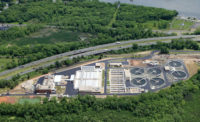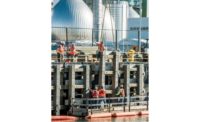Asplund WWTF Disinfection Upgrade Project
Anchorage, Alaska
Best Project
Owner/Developer Anchorage Water & Wastewater Utility
General Contractor Roger Hickel Contracting Inc.
Lead Design Firm GV Jones & Associates Inc.
Subcontractors Reid Middleton; RSA Engineering; UMIAQ; Electric Power Systems
The $11-million upgrade to the Asplund Wastewater Treatment Facility’s disinfection system allowed the Anchorage, Alaska, facility to stop using hauled-in chlorine gas for disinfection and instead use potentially less dangerous sodium hypochlorite to create chlorine gas on demand.
Phase 1 of the project entailed the renovation of a portion of the facility and the installation of storage tanks, along with completion of a sodium hypochlorite storage and dosing system. The chlorine system remained in place, including a 28-ton storage tank and weekly 8-ton shipments, as the new system was operated in test mode.
“Once the system was completely operational, the remaining chlorine gas was used up and decommissioned. At that point we began the construction of the hypo processing equipment,” says Mark Powers, project manager for general contractor Roger Hickel Contracting Inc.
The use of potentially harmful chemicals at the facility translated into site-specific scheduling concerns, Powers says.
“Pouring the concrete walls early was important due to special anti-corrosion coatings that need the concrete to be cured for 30 days and seven days for application,” Powers says.
Phase 2 involved preparing and installing the onsite hypochlorite generation facilities that use the chlor-alkali process to create chlorine. Simply, the process uses a membrane in a brine solution of sodium chloride resulting in chlorine gas forming at the anode and caustic, along with a small amount of hydrogen gas, forming at the cathode.
The general contractor was also tasked with bringing the 44-year-old building up to current codes and making seismic improvements that met international fire codes. New features included a roof system, concrete spill containment structures, space heating and ventilation systems, fire alarm and fire sprinkler systems, and power distribution system upgrades.
The spill containment structures are cast-in-place concrete walls at varied widths with fibermesh and Hycrete X1000 to inhibit corrosion. Powers says the rebar was also epoxy coated for further corrosion resistance, and floors in tank and salt storage areas were covered with corrosion resistant epoxy coating. Corrosion prevention measures were taken on every aspect of the project. “All of the fasteners used in the structure, including anchor bolts, had to be stainless steel to withstand the corrosion,” Powers adds.
Subcontractors also installed fiberglass reinforced plastic panels over insulated furred walls for durability and chemical resistance. The 10,000-sq-ft phased project that overlooks the Cook Inlet was completed on time and on budget.





Post a comment to this article
Report Abusive Comment